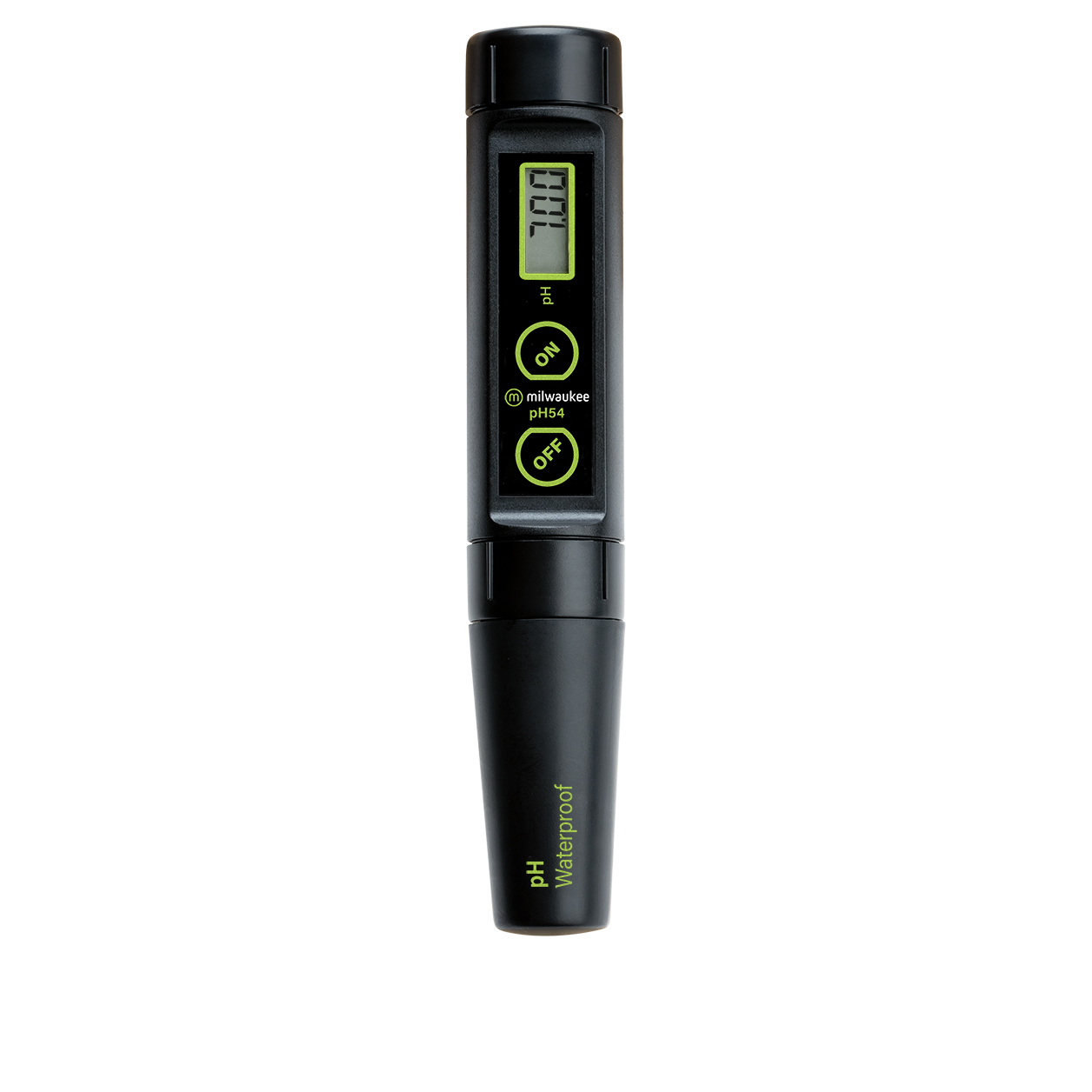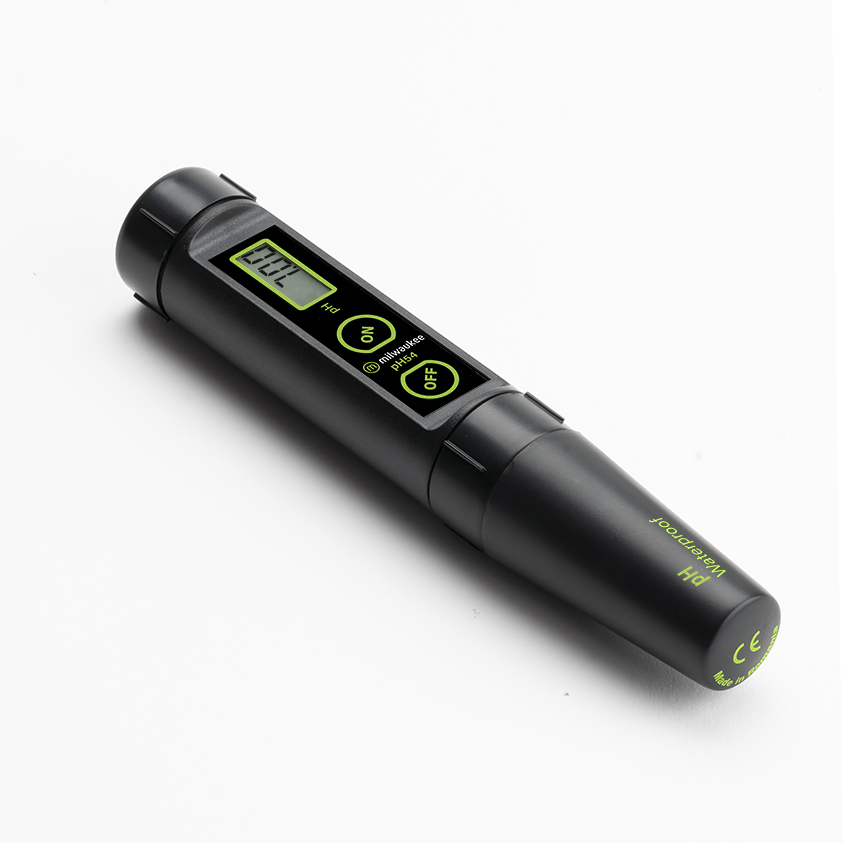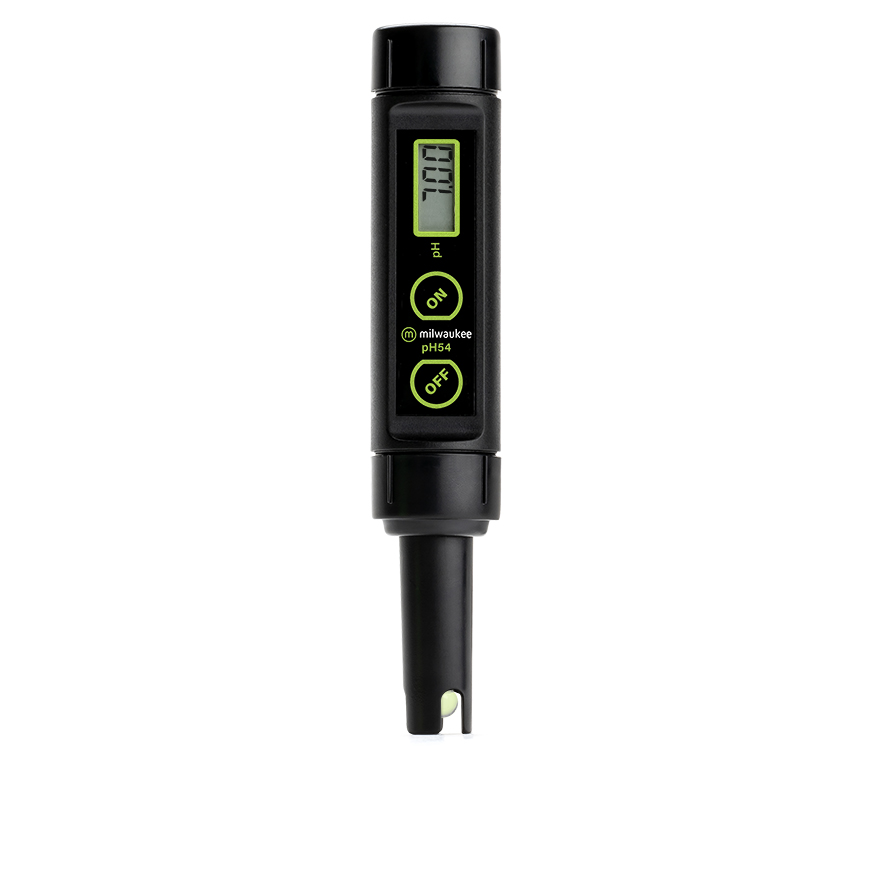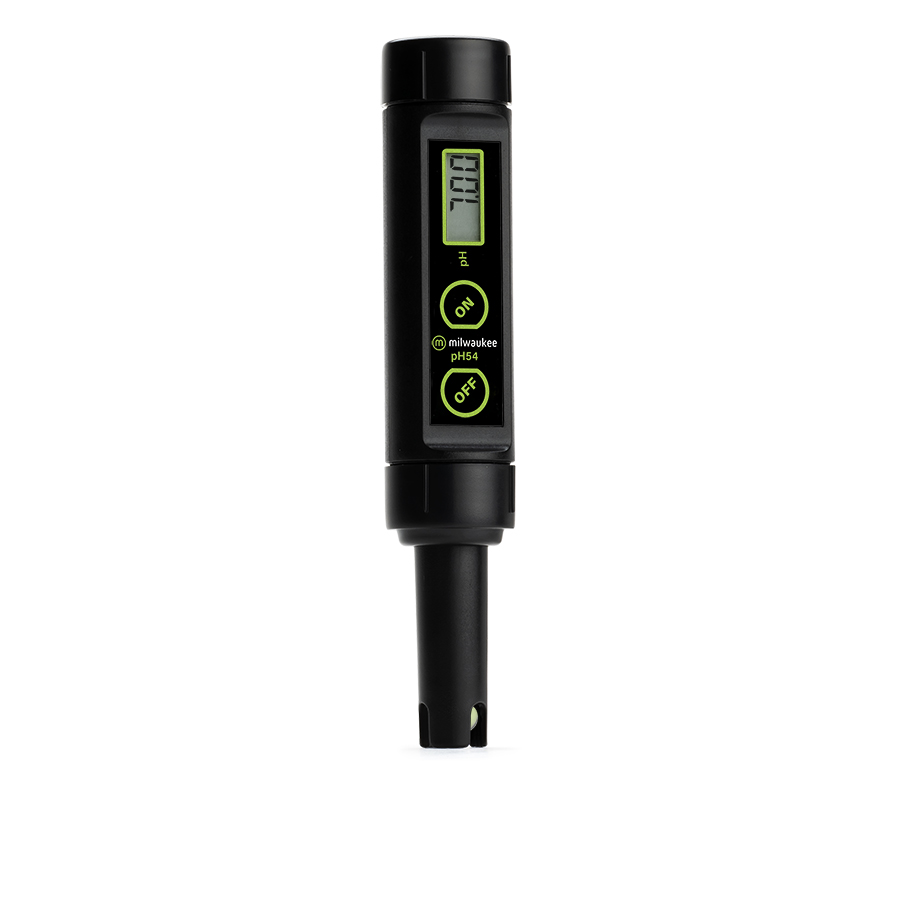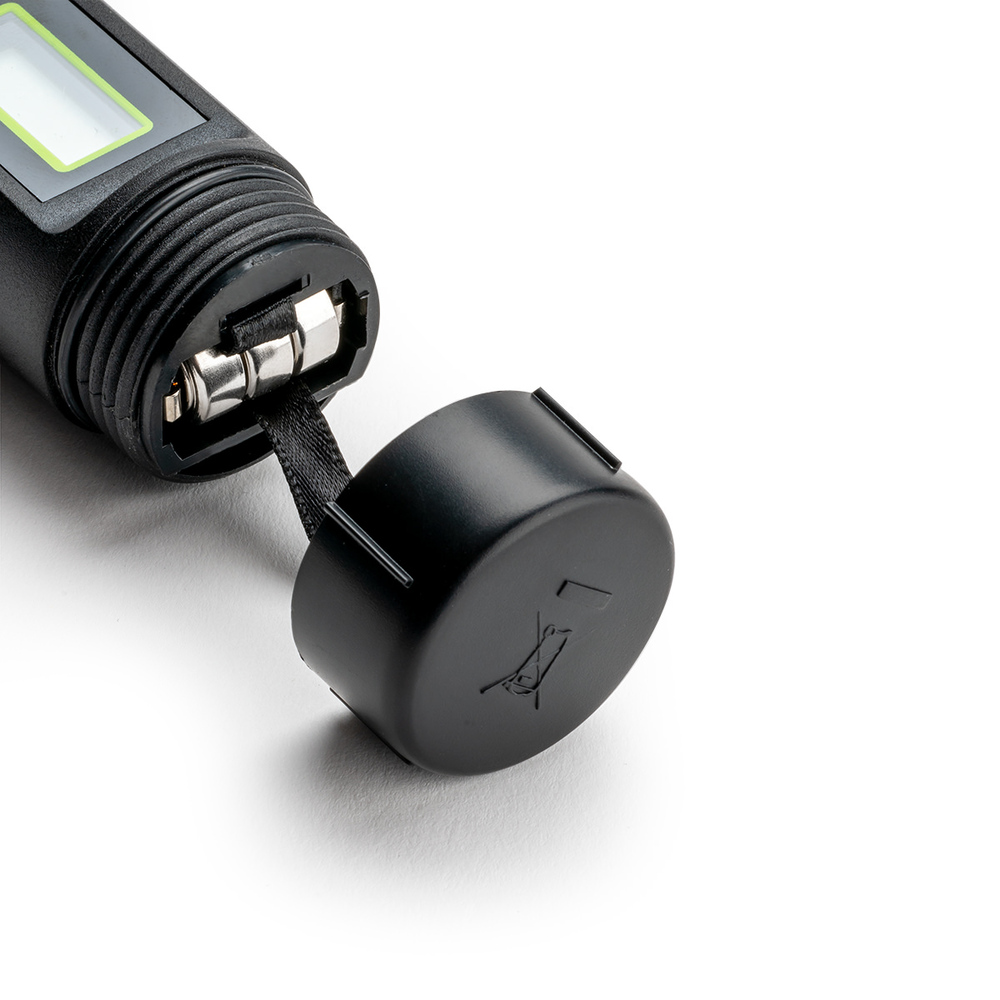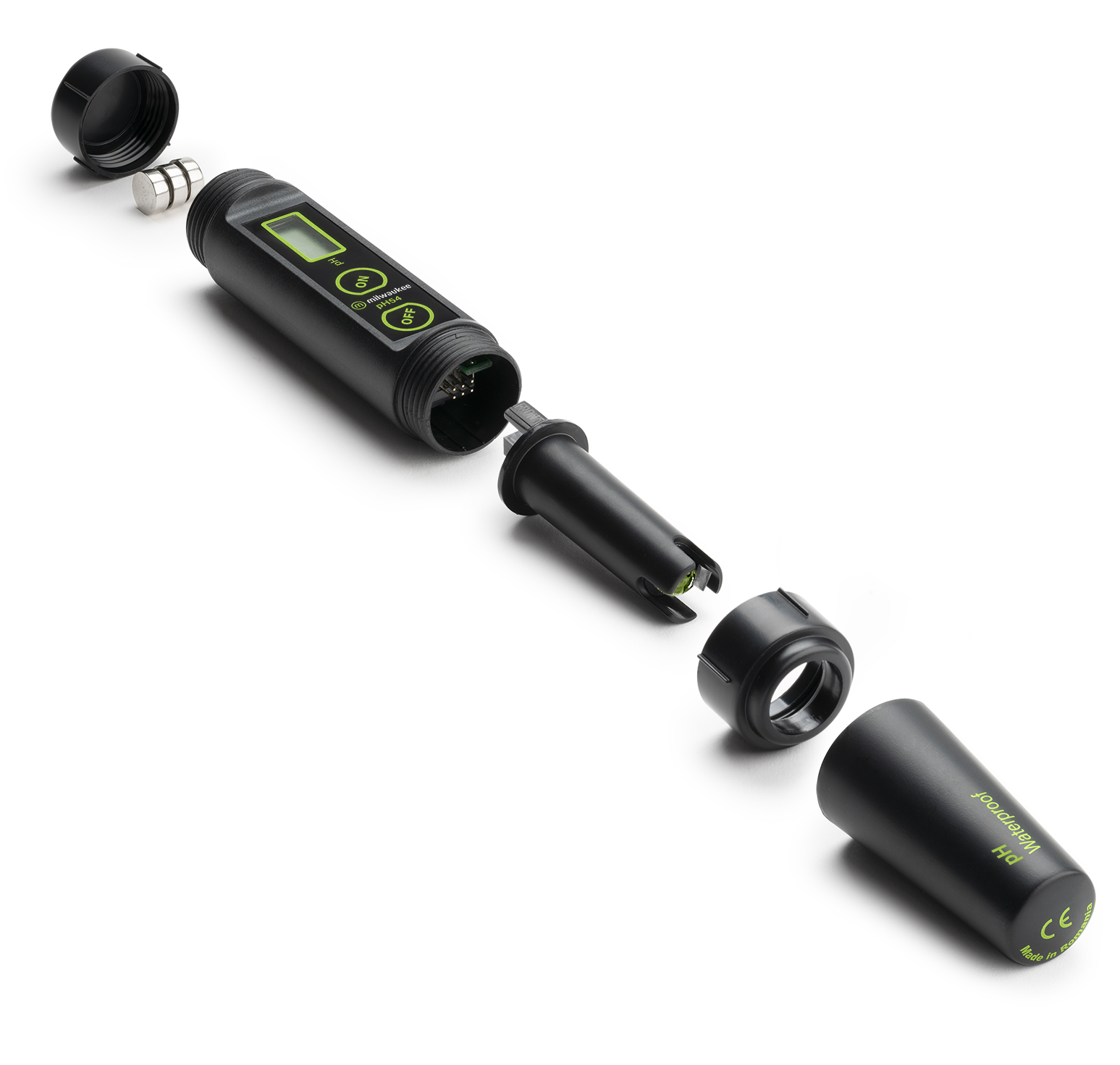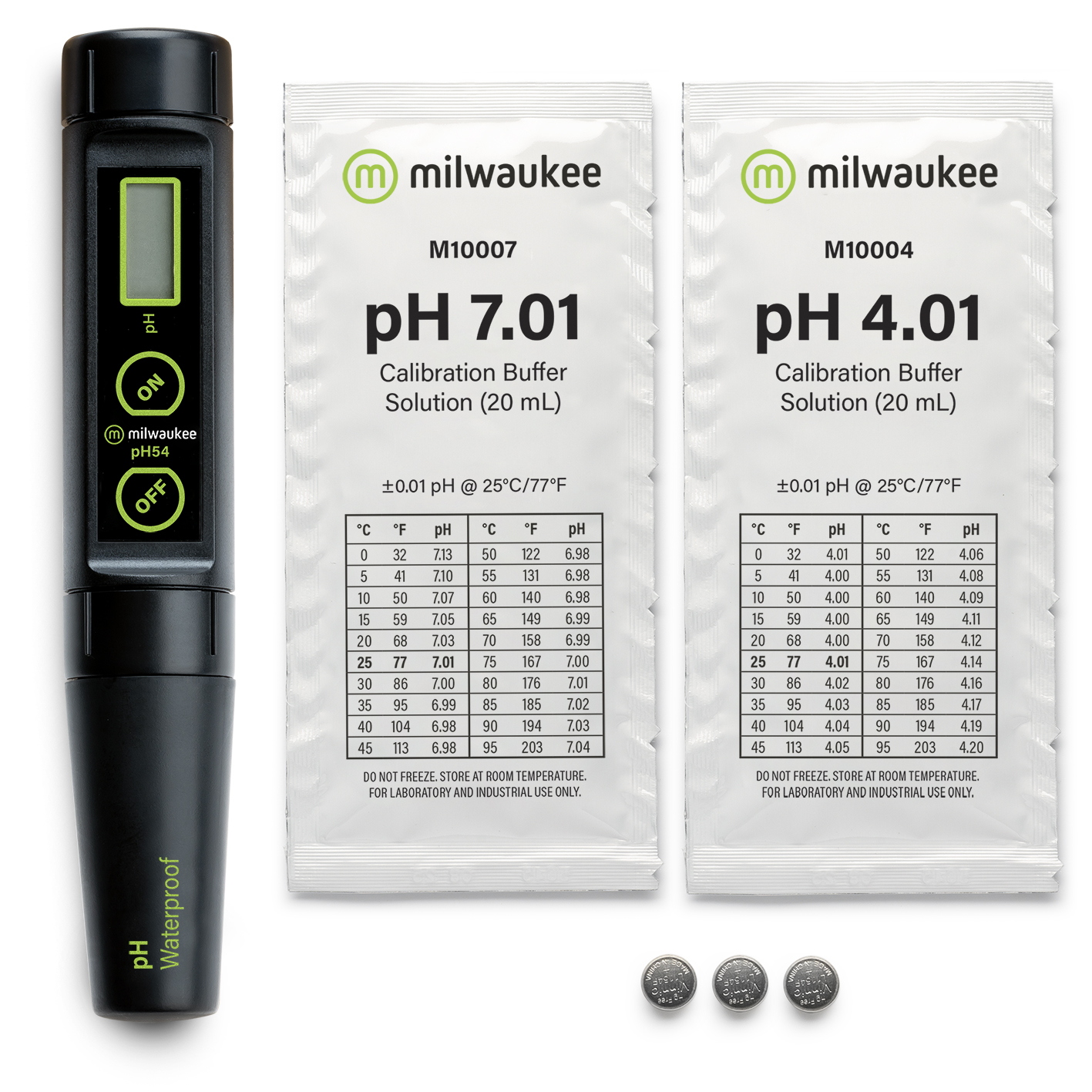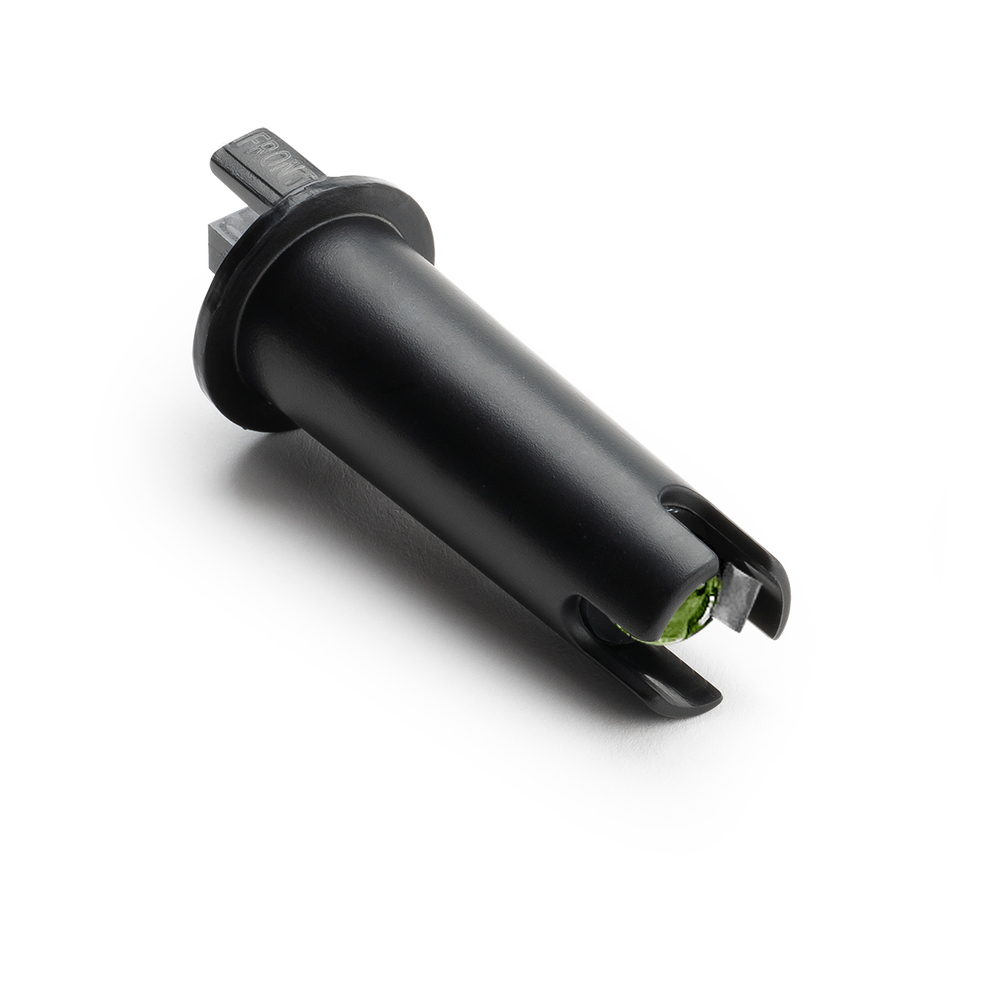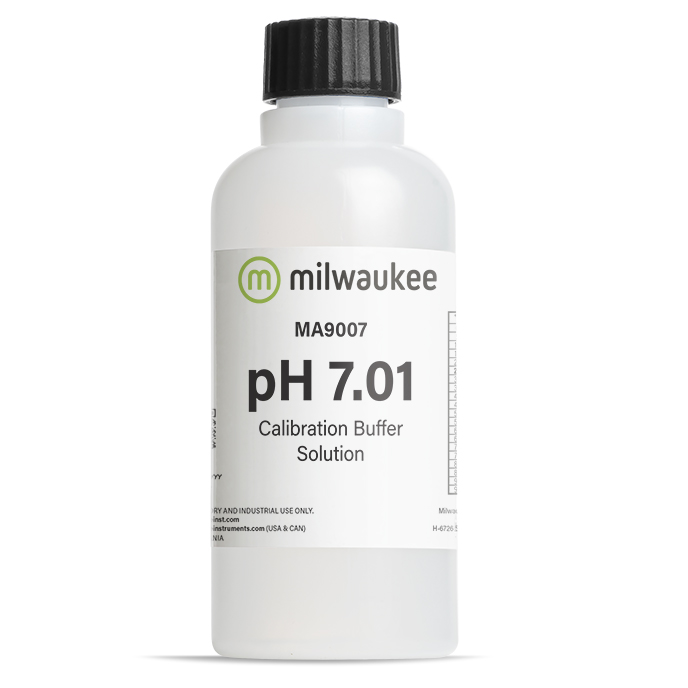Your shopping cart is currently empty.
Milwaukee pH54 Waterproof pH Tester with Replaceable Probe – Trusted pH Accuracy for Water Quality Enthusiasts & Professionals
Whether you’re fine-tuning a hydroponic system, caring for an aquarium, or verifying the pH of your irrigation water, precision pH measurement is the foundation of success. The Milwaukee pH54 Waterproof pH Tester has been designed for one purpose: to deliver accurate, reliable, and hassle-free pH readings, even in challenging environments.
Trusted by growers, aquarists, educators, and environmental professionals worldwide, the pH54 combines accuracy, durability, and affordability in a handheld, waterproof tester that’s easy to use and maintain. From hydroponic growers adjusting nutrient solutions, to wastewater technicians monitoring effluent, to aquarists keeping aquatic life in balance – Milwaukee’s pH54 provides fast, dependable results where they matter most.
Unlike single-use testers or fragile meters, the pH54 offers a long-lasting solution thanks to its replaceable, double-junction probe and IP65-rated waterproof casing. Calibration is fast and straightforward with simple, manual one- or two-point calibration. Its compact size fits easily in a pocket or toolbox, ready to support you on-site or in the lab whenever you need precise pH measurement.
Because when water quality is your business – or your passion – there’s no time for guesswork.
Why Choose the Milwaukee pH54?
- Precision at Your Fingertips: Achieve accurate measurements from 0.00 to 14.00 pH with ±0.1 pH accuracy and 0.01 resolution – essential for critical water monitoring tasks.
- Durability Built In: The IP65 waterproof design withstands wet and rugged environments, making it ideal for fieldwork, farms, and laboratories.
- Replaceable Probe for Longevity: Features a double-junction, replaceable pH probe (SE520) – a cost-effective solution that extends the life of your tester.
- User-Friendly Calibration: Manual one- or two-point calibration ensures optimal accuracy and adapts easily to your testing routines.
- Clear, Easy-to-Read Display: Large, dual-level LCD shows pH and temperature simultaneously for at-a-glance readings.
- Compact, Portable, and Practical: Designed for easy transport and immediate use in a wide range of environments.
- Automatic Temperature Compensation (ATC): Ensures precision readings, even with changing sample temperatures.
Applications
The Milwaukee pH54 is a versatile and dependable solution trusted across a broad range of industries and hobbies:
Hydroponics & Soilless Cultivation
Ensure optimal nutrient absorption by maintaining precise pH in your nutrient solutions. Critical for maximizing plant health and yields.
Aquariums & Aquaculture
Maintain stable, healthy water chemistry for fish, corals, and other aquatic organisms. Prevent harmful pH swings that can stress or damage aquatic life.
Horticulture & Agriculture
Monitor irrigation water and soil slurries to optimize pH for crop performance, from greenhouse operations to open fields.
Water & Wastewater Treatment
Ideal for technicians monitoring pH in effluents and process streams to ensure regulatory compliance and treatment efficiency.
Education & Laboratories
Perfect for teaching environments, research labs, and field studies – offering hands-on experience with professional-grade accuracy.
Food & Beverage Production
Supports quality control processes where water pH impacts flavor, safety, and consistency (brewing, winemaking, cheese making, etc.).
Pools & Spas
Ensures balanced water chemistry for safety, comfort, and equipment protection.
Environmental Field Testing
Robust enough for fieldwork, whether monitoring rivers, lakes, or runoff for ecological assessments.
Proper Care & Maintenance
A pH tester’s performance relies heavily on the condition of its probe. To extend the life and accuracy of your Milwaukee pH54, follow these care guidelines:
Storage
- Never store the probe dry. Dry storage damages sensitivity and risks clogging the reference junction.
- Use storage solution or pH 4.01/7.01 calibration buffer to keep the probe hydrated. Avoid tap or distilled water.
- Store the electrode upright with storage solution in the cap to prevent leakage and dehydration.
Cleaning
- Residue buildup from samples can affect accuracy. Regular cleaning with electrode cleaning solution prevents contamination and restores performance, especially after exposure to organic-rich or protein-heavy samples.
Calibration
- Calibrate regularly – before each use if possible, or at least weekly for continuous reliability.
- Always recalibrate after cleaning or extended storage periods.
- The pH54 supports easy 1- or 2-point calibration for fast and accurate results.
Enhance Your Water Quality Testing with Confidence
With its reliable performance, rugged construction, and user-friendly design, the Milwaukee pH54 Waterproof pH Tester delivers peace of mind to those who demand precision in their water quality monitoring – whether in the greenhouse, the lab, or the field.
Specifications
Application
Aquariums & Fishkeeping
Maintaining a healthy aquatic environment requires more than clean water – it requires stable, species-appropriate pH levels. The pH of water directly affects the biological functions of fish, plants, and beneficial bacteria in your tank. Even small fluctuations can cause stress, inhibit growth, compromise immunity, or in extreme cases, lead to death.
For both freshwater and marine aquariums, the Milwaukee pH54 Waterproof pH Tester is an essential tool. It offers fast, accurate, and portable pH measurement, helping you make informed decisions about water treatments, buffering agents, and maintenance routines.
Certain fish species – like Discus, Neon Tetras, or Betta – require slightly acidic water, while others like African Cichlids or livebearers thrive in alkaline conditions. Marine setups, including reef tanks, have even tighter pH tolerances. Testing regularly with a precise instrument like the pH54 allows aquarists to catch and correct deviations before they cause harm.
Furthermore, pH stability is vital for biological filtration. Beneficial bacteria that break down ammonia into nitrite and nitrate are sensitive to pH shifts. If the pH drops too low, it can impair this cycle, leading to toxic buildups and compromised water quality.
How to Use the Milwaukee pH54 in Aquariums & Fishkeeping
Using the pH54 for aquarium maintenance is simple and fast. Here’s a step-by-step guide to get the most accurate results and ensure aquatic health:
Prepare the Tester
- Make sure your pH54 has been recently calibrated using pH 7.01 and 4.01 buffers.
- Ensure the probe is clean and stored properly before use.
- If dry or recently cleaned, hydrate the probe in storage solution for at least 15 minutes.
Take a Measurement
- Turn the pH54 on.
- Rinse the probe in aquarium water or distilled water to avoid contamination.
- Submerge the probe tip 2–3 cm into the aquarium water, ideally in a well-circulated area.
- Wait for the reading to stabilize (usually within a few seconds).
- Record the pH value shown on the LCD screen.
Interpret & Adjust
- Compare the reading to the ideal pH range for your tank’s inhabitants:
- Freshwater Tropical Fish: 6.5–7.5 (species-dependent)
- African Cichlids: 7.8–8.6
- Marine Fish/Reef Tanks: 8.0–8.4
- If the pH is outside of the desired range, use a pH buffer, chemical adjuster, or partial water change to bring it into balance gradually.
Rinse and Store
- Rinse the probe with distilled water.
- Refill the cap with storage solution and securely cover the probe.
- Store the pH54 upright in a cool, dry place.
Suggested Maintenance Schedule for Aquarium Use
|
Task |
Frequency |
|
Calibrate pH54 |
Weekly or biweekly |
|
Test aquarium pH |
2–3 times per week |
|
Clean the probe |
Monthly |
|
Soak in storage solution |
After each use / weekly |
|
Replace probe |
Every 6–12 months (or as needed) |
The Milwaukee pH54 gives fishkeepers peace of mind with accurate, fast, and repeatable readings, empowering both hobbyists and professionals to create safe, thriving aquatic ecosystems.
Hydroponics & Soilless Cultivation
In hydroponics and other soilless growing systems, controlling pH is not optional – it’s essential. Unlike traditional agriculture, where soil can buffer and regulate nutrients to some degree, hydroponic nutrient delivery is direct and immediate. If the pH of your nutrient solution is outside the optimal range, your plants won’t absorb the nutrients you’ve provided – even if they’re present in ideal concentrations.
The Milwaukee pH54 Waterproof pH Tester is a reliable, grower-trusted tool designed to help you maintain perfectly balanced nutrient solutions for maximum plant health, growth speed, and yield. With its high-resolution LCD and ±0.1 pH accuracy, the pH54 allows you to spot and correct pH shifts before they lead to stunted growth, nutrient lockout, or costly crop failures.
Different crops thrive at different pH levels, but most hydroponic systems target a pH range between 5.5 and 6.5 – a narrow window where essential macro and micronutrients like nitrogen, calcium, magnesium, and iron are most bioavailable. Drift just half a point outside that range and your plants may begin to show signs of deficiency, toxicity, or stress.
Whether you're growing lettuce in deep water culture, tomatoes in coco coir, or cannabis in rockwool, the Milwaukee pH54 gives you the accuracy and durability to maintain ideal growing conditions – day in and day out.
How to Use the Milwaukee pH54 in Hydroponics & Soilless Systems
Growers can easily integrate the pH54 into daily feeding and maintenance routines. Here’s a step-by-step guide:
Prepare and Calibrate
- Before your first use of the day, calibrate the pH54 with pH 7.01 and 4.01 buffer solutions.
- Rinse the probe with distilled water and blot dry (do not wipe to avoid static).
- If stored dry, rehydrate the probe in storage solution for at least 15 minutes.
Test Your Nutrient Solution
- Stir your nutrient reservoir or solution to ensure uniformity.
- Turn on the pH54.
- Rinse the probe with a small sample of your nutrient water (or distilled water).
- Submerge the probe into the solution 2–3 cm deep, ensuring the sensor is fully immersed.
- Wait for the reading to stabilize (typically 10–20 seconds).
- Record the pH value and determine whether adjustment is needed.
Adjust and Re-Test if Necessary
- If the reading is too high (alkaline), add a pH Down solution (phosphoric acid-based for plants).
- If the reading is too low (acidic), use a pH Up solution (often potassium hydroxide-based).
- Always adjust slowly – a few drops at a time – and mix thoroughly before re-testing.
- Recheck the pH after each adjustment until you reach the desired range (usually 5.8–6.2 for most crops).
Clean and Store
- After testing, rinse the probe with distilled water to remove any nutrient residue.
- Place the cap back on with fresh storage solution or calibration buffer inside.
- Store upright in a cool, shaded location.
Pro Tip for Growers
pH isn’t static – it fluctuates with temperature, root activity, and microbial life. That’s why the Automatic Temperature Compensation (ATC) feature of the Milwaukee pH54 is so valuable: it ensures that your readings reflect actual nutrient availability under real-world conditions.
The pH54 is especially helpful for:
- EC-to-pH balancing routines
- Flushes and reservoir changes
- Coco coir pre-treatment (buffering)
- Aeroponic and drip systems with tight nutrient windows
With the Milwaukee pH54, hydroponic growers gain real-time insight into the chemistry of plant health, allowing them to make smarter, faster decisions that translate into stronger growth and higher yields.
Horticulture & Agriculture
Soil and water pH directly affect nutrient availability, root development, and overall crop performance. In both open-field agriculture and greenhouse horticulture, even small pH imbalances can reduce fertilizer efficiency, weaken plant defenses, and lead to yield losses. That’s why accurate, portable pH testing is a vital tool for growers seeking consistent, healthy crops.
The Milwaukee pH54 Waterproof pH Tester is a rugged, field-ready solution designed for soil slurry testing and irrigation water monitoring. Whether you’re managing vegetable plots, fruit orchards, greenhouses, or commercial farms, the pH54 empowers you to measure, track, and correct pH conditions with confidence.
In agriculture, soil pH affects nutrient solubility – a soil that is too acidic (low pH) may lock out calcium, magnesium, and phosphorus, while a soil that is too alkaline (high pH) can reduce the availability of iron, manganese, and zinc. Similarly, the pH of irrigation water can shift soil chemistry over time and impact plant response to fertilizers.
By regularly testing both irrigation water and soil slurry samples, farmers can make data-driven decisions about liming, fertilization, acidification, or irrigation management. The Milwaukee pH54’s waterproof casing and replaceable probe make it ideal for use in the field, at the greenhouse, or during routine fertigation checks.
How to Use the Milwaukee pH54 in Horticulture & Agriculture
The pH54 is an indispensable tool for growers performing on-site testing. Here's how to use it effectively in soil and water sampling:
Testing Irrigation Water
- Calibrate the pH54 using pH 7.01 and 4.01 buffers before first use or as part of your weekly routine.
- Collect a fresh irrigation water sample in a clean container.
- Turn on the meter and rinse the probe with distilled water or a bit of the sample.
- Submerge the probe tip into the water and wait for the reading to stabilize.
- Record the pH and determine if adjustments are needed (e.g., acidifying high-pH water).
Soil Slurry pH Testing
Soil pH cannot be tested directly with a pH meter – it must be extracted into a slurry or solution. Here's the standard process:
- Collect a soil sample from 5–6 inches below the surface. Mix samples from different spots in a field for a representative test.
- Dry and sieve the soil to remove debris and stones (if possible).
- Mix 1 part soil with 1 part distilled water (1:1 ratio) in a clean container (e.g., 50 g soil with 50 mL water).
- Stir thoroughly and let it settle for 10–15 minutes.
- Rinse the pH54 probe with distilled water, then insert into the clear portion of the slurry (not touching the sediment).
- Wait for the reading to stabilize and record the pH.
After Use
- Rinse the probe with distilled water.
- Refill the cap with storage solution or buffer to keep the probe hydrated.
- Store upright in a cool, dry place, away from direct sunlight.
Where the Milwaukee pH54 Makes a Difference
- Greenhouse tomato or cucumber growers checking nutrient tank pH
- Citrus and berry growers managing soil acidity
- Orchard managers balancing pH for micronutrient uptake
- Turf professionals and landscapers optimizing soil conditions
- Field crop farmers determining lime or sulfur application needs
With its IP65 waterproof rating, compact design, and replaceable double-junction probe, the Milwaukee pH54 gives farmers and horticulturists a practical edge in managing soil health and crop success. It’s a tool that pays for itself through better yields, improved input efficiency, and more resilient plants.
Wastewater & Water Treatment
In wastewater management, accurate pH monitoring is more than best practice – it’s a regulatory requirement. Whether treating industrial effluent, managing municipal outflows, or maintaining water quality in cooling towers and processing systems, maintaining the correct pH is essential for protecting infrastructure, meeting environmental discharge standards, and safeguarding ecosystems.
The Milwaukee pH54 Waterproof pH Tester offers a fast, rugged, and reliable solution for professionals conducting on-site water testing. With a ±0.1 pH accuracy and a durable, IP65-rated waterproof casing, the pH54 is ideally suited for tough environments such as treatment plants, tanks, manholes, and drainage channels.
pH levels in wastewater must be kept within strict limits – typically between 6.0 and 9.0 for discharge compliance in most jurisdictions. Exceeding these values can lead to fines, environmental damage, and system inefficiencies. In treatment processes such as neutralization, precipitation, flocculation, and biological digestion, pH is a critical control parameter.
Whether you’re verifying pre-treatment processes, adjusting chemical dosing, or conducting final effluent checks before discharge, the Milwaukee pH54 gives you the confidence and clarity to take action, fast.
How to Use the Milwaukee pH54 for Wastewater & Water Treatment
The pH54 is engineered for fast, dependable field use. Here’s how to get accurate results in harsh or variable water environments:
Preparation and Calibration
- Start by calibrating the meter using pH 7.01 and 4.01 buffer solutions. This ensures optimal accuracy when dealing with unknown or fluctuating sample conditions.
- If the probe has been dry or unused for a while, soak it in storage solution to rehydrate the junction.
Sample Collection or Direct Testing
You can either test directly in the process stream or use a grab sample method:
- For grab sampling, collect wastewater in a clean, chemical-resistant container (preferably plastic or glass).
- For on-site testing, rinse the probe with distilled water or a portion of the sample to prevent contamination from prior measurements.
Measurement
- Turn on the meter and insert the probe into the sample or process stream.
- Immerse the sensor tip at least 2–3 cm, ensuring it’s fully submerged and not touching container walls or surfaces.
- Allow the reading to stabilize – typically within 10–30 seconds, depending on the temperature and chemical composition.
- Read and record the pH value shown on the LCD screen.
Note: If testing strongly colored, viscous, or high-sediment samples, ensure the junction is not fouled. Clean the probe immediately after use.
Post-Use Cleaning & Storage
- Rinse the probe thoroughly with distilled or deionized water to remove residual chemicals or sludge.
- Gently blot (do not wipe) the probe tip with a lint-free cloth.
- Fill the probe cap with storage solution or buffer, reseal it, and store the pH54 upright in a shaded, dry location.
Where the pH54 Excels in Wastewater Applications
- Effluent discharge verification before release into public waterways
- Neutralization basin monitoring during chemical treatment processes
- Aeration tank checks in biological treatment systems
- Influent assessment from industrial outflows (e.g., food processing, textiles, pharma)
- Cooling system water treatment for scaling/corrosion prevention
- Field spot checks by environmental inspectors and compliance officers
The Milwaukee pH54 is more than a lab tool – it’s a mobile field companion, giving wastewater professionals the durability and accuracy they need to keep systems running efficiently and within environmental compliance.
Education & Laboratory Work
In science education, hands-on learning is key to developing real-world understanding – and few tools are more versatile or instructive than a high-quality pH meter. The Milwaukee pH54 Waterproof pH Tester is a classroom favorite and a trusted lab companion, offering students and instructors a reliable way to explore concepts in chemistry, biology, agriculture, environmental science, and applied technology.
With its intuitive interface, visible dual-level LCD screen, and manual one- or two-point calibration, the pH54 teaches the fundamentals of pH measurement in a way that’s tactile, transparent, and directly tied to scientific principles. Students gain experience not only in reading pH values, but in preparing calibration standards, cleaning probes, analyzing results, and interpreting experimental data.
In educational labs – from middle school science classrooms to university research facilities – the pH54 brings real instrumentation into learning. It bridges the gap between theory and practice, preparing students for more advanced tools and analytical techniques used in research and industry. Its waterproof design and replaceable probe also make it highly cost-effective for repeated use, even by beginners.
Whether demonstrating acid-base reactions, testing household substances, or monitoring pH in environmental samples or biological experiments, the Milwaukee pH54 provides a safe, accurate, and durable platform for inquiry and discovery.
How to Use the Milwaukee pH54 in Education & Laboratory Settings
The pH54 is ideal for student labs, demonstrations, and instructor-led experiments. Here’s how to integrate it effectively into classroom or lab work:
Introduce the Components
Before beginning any activity, instructors can review:
- The purpose of the pH meter
- The function of the electrode, LCD display, and calibration system
- The concept of pH scale (0–14), and how it relates to acids, bases, and neutrality
Calibration Exercise
Calibration is not just a maintenance step – it’s a teaching opportunity. Here’s how to walk students through it:
- Rinse the electrode with distilled water and blot gently.
- Place the electrode in pH 7.01 buffer solution and press the CAL button (if using).
- Wait for the reading to stabilize. If performing two-point calibration, repeat with pH 4.01 (or 10.01) buffer.
- Explain to students why calibration matters and how buffers help establish reference points.
Sample Measurement
Once calibrated, students can test various solutions, such as:
- Tap water, vinegar, lemon juice, soap solution, or baking soda mixtures
- Unknown solutions in titration experiments
- Water from natural sources like ponds or rain
- Rinse the electrode between each sample with distilled water.
- Immerse the probe tip in the test solution (at least 2–3 cm deep).
- Wait 10–20 seconds for the reading to stabilize.
- Record the pH and analyze the result (acidic, neutral, or basic?).
Clean-Up and Storage
After testing:
- Rinse the electrode with distilled water.
- Refill the cap with storage solution or pH buffer.
- Instruct students to store the unit upright in a safe location.
Suggested Lab Uses and Learning Objectives
- Chemistry Labs: Demonstrating acid/base behavior, buffer capacity, and titration endpoints
- Biology & Environmental Science: Monitoring pH in natural samples or biological processes (fermentation, decomposition, etc.)
- Agricultural Studies: Analyzing soil slurries or nutrient solutions
- Technical Education: Training future lab technicians and plant operators in instrument calibration and field protocols
With the Milwaukee pH54, educators provide students with a reliable, hands-on introduction to scientific instrumentation – helping them build skills, confidence, and curiosity that extend well beyond the classroom. It's a teaching tool that blends precision and simplicity, making it ideal for both learning and practical experimentation.
Brewing & Beverage Production
In beverage production – whether it’s craft beer, wine, cider, kombucha, or cold brew coffee – pH plays a pivotal role in shaping flavor, texture, appearance, and microbiological stability. The Milwaukee pH54 Waterproof pH Tester is an indispensable tool for brewers and artisans seeking to elevate product consistency, control fermentation, and fine-tune the sensory experience.
From mash and wort in brewing, to must and fermenting juice in winemaking, to fermentation management in all beverage types, monitoring pH gives producers direct insight into enzymatic activity, yeast performance, acidity balance, and shelf life. A drop in pH can signal healthy fermentation – or, in the wrong context, a risk of spoilage. And during brewing, even minor pH adjustments in the mash or sparge can have a noticeable effect on clarity, conversion efficiency, and final taste.
For professional brewers and home enthusiasts alike, the Milwaukee pH54 offers the perfect combination of precision, portability, and affordability. Its ±0.1 pH accuracy, waterproof housing (IP65), and replaceable probe make it suitable for both production floors and kitchen counters. And unlike test strips or color kits, the pH54 delivers fast digital readings you can trust – even in hot or cold, low or high acid environments.
How to Use the Milwaukee pH54 in Brewing & Beverage Applications
Here’s a practical step-by-step guide for getting the most out of the pH54 across multiple stages of beverage production.
1. Calibration Before Use
- Always calibrate before testing, especially if you’re working in high-sugar, low-pH, or protein-rich environments (like must or mash).
- Use fresh pH 7.01 and 4.01 buffer solutions for accurate calibration.
- Rinse the electrode between buffers with distilled water to avoid cross-contamination.
- If the probe has been dry, soak it in storage solution for 15+ minutes before calibration.
3. Rinse and Clean the Probe
- After each use, rinse the probe with distilled water to remove sugars, proteins, and acids.
- For sticky or organic-rich samples (like must or kombucha), periodically soak the probe in electrode cleaning solution to prevent buildup and ensure accurate performance.
4. Storage
- Fill the probe cap with storage solution or pH buffer, not distilled or tap water (which damages the probe).
- Store upright to prevent leakage and keep the junction hydrated.
Ideal for a Wide Range of Beverage Applications
- Craft breweries managing mash pH and fermentation tracking
- Wineries monitoring must, fermentation kinetics, and stability
- Cideries ensuring proper acidity during and post-fermentation
- Kombucha brewers safeguarding pH for fermentation safety
- Coffee roasters/cold brew producers optimizing brew extraction pH
- Sour beer and mixed fermentation producers fine-tuning complex microbial interactions
With the Milwaukee pH54, beverage makers gain precision control over every batch – leading to better flavor, reduced spoilage risk, and confident fermentation management. It’s a compact, professional-grade tool that brings scientific precision to the art of beverage making.
Pool & Spa Water Quality Checks
In both residential and commercial pool & spa maintenance, keeping pH levels properly balanced is essential for bather safety, equipment longevity, and water clarity. While the Milwaukee pH54 Waterproof pH Tester is primarily designed for agricultural, hydroponic, and industrial use, it has proven to be a reliable, cost-effective solution for pool and spa owners seeking more precise, digital pH measurements than traditional test strips or color comparator kits.
Unbalanced pH can cause a range of problems in pool and spa environments:
- Low pH (<7.2): Leads to eye and skin irritation, corrosion of metal fixtures, etching of pool surfaces, and degradation of equipment like pumps and heaters.
- High pH (>7.8): Causes cloudy water, scale formation, and reduced effectiveness of chlorine sanitizers – making it harder to control bacteria and algae.
The ideal pH range for most pools and spas is 7.2 to 7.6, where water feels comfortable, chlorine is most effective, and damage to infrastructure is minimized.
With its ±0.1 pH accuracy, automatic temperature compensation (ATC), and IP65 waterproof housing, the Milwaukee pH54 offers precise readings you can rely on – indoors or outdoors, by the poolside or at the spa.
How to Use the Milwaukee pH54 for Pool & Spa Maintenance
Here’s a step-by-step guide to using the pH54 effectively for routine water testing:
Preparation and Calibration
- Calibrate the meter using pH 7.01 and 4.01 buffer solutions. This is especially important if it hasn’t been used recently.
- Rinse the electrode with distilled water after calibration to remove buffer residue.
- If the probe has been stored dry, rehydrate in storage solution for 15 minutes.
Water Sampling
- Take a clean water sample from your pool or spa using a plastic or glass container.
- Avoid collecting water from the surface or near return jets – aim for water about 30 cm (12 inches) below the surface, where readings are most accurate.
- Rinse the probe with a small amount of the sample to remove any contamination.
Testing
- Insert the probe into the water sample, ensuring the sensor is fully submerged (2–3 cm).
- Wait for the reading to stabilize – usually within 10–15 seconds.
- Record the pH value. Compare it against the recommended range:
- Ideal pool/spa pH: 7.2–7.6
Interpretation & Adjustment
- If pH is too low (<7.2), add a pH increaser (sodium carbonate).
- If pH is too high (>7.6), add a pH reducer (sodium bisulfate or muriatic acid).
- Retest 30–60 minutes after circulation to confirm that levels have stabilized.
Cleaning & Storage
- Rinse the probe thoroughly with distilled water to remove chlorine, salt, or other residues.
- Fill the protective cap with storage solution or buffer and close it securely.
- Store the tester upright in a dry, shaded area.
When to Use the Milwaukee pH54 for Pool/Spa Monitoring
While not marketed specifically to pool professionals, the pH54 is ideal for:
- DIY pool owners seeking more reliable readings than strips or comparators
- Saltwater spa users, where accurate pH helps maintain chlorine generation
- Small hotel/resort pools with budget-conscious maintenance teams
- Hot tub owners where high water temperatures affect sanitizer efficiency
- Seasonal checks during pool openings and closings
With the Milwaukee pH54, pool and spa owners gain a digital edge in water management – resulting in safer swimming, clearer water, and less chemical waste. It’s a practical upgrade for anyone who wants better control over their pool’s chemistry without investing in bulky or expensive professional-grade kits.
Environmental Field Testing & Industrial Process Monitoring
Monitoring pH in the field or during industrial operations is vital for regulatory compliance, safety, and environmental stewardship. Whether you're sampling rainwater in a remote watershed, checking pH in a factory cooling tower, or analyzing runoff from an agricultural site, you need a tool that is accurate, durable, and portable.
The Milwaukee pH54 Waterproof pH Tester is designed to meet those challenges head-on. With ±0.1 pH accuracy, automatic temperature compensation (ATC), a dual-level LCD, and an IP65 waterproof casing, the pH54 delivers professional-grade results in rugged outdoor or industrial environments.
For environmental testing, pH is a key indicator of ecosystem health and pollutant impact. Sudden changes in stream or lake pH can signal chemical contamination, acid rain, or algal blooms. For regulators, scientists, and educators, real-time data from the pH54 helps inform decisions about water quality management, remediation, and conservation.
In industrial settings, such as chemical manufacturing, food processing, or metal finishing, spot-checking pH in rinse baths, process tanks, or cooling loops is essential for process efficiency and material integrity. Unchecked pH drift can lead to corrosion, scaling, and product inconsistencies. The Milwaukee pH54 offers a fast and affordable way to verify chemical conditions at any point in the production or maintenance cycle.
How to Use the Milwaukee pH54 in Environmental & Industrial Applications
Here’s a structured guide for accurate, reliable pH measurement in field and industrial contexts.
Pre-Field or Pre-Shift Preparation
- Calibrate the pH54 using fresh pH 7.01 and 4.01 (or 10.01) buffer solutions.
- If you're heading into the field, carry calibration buffers and distilled water in portable containers.
- Make sure the electrode has been stored in proper storage solution, and rehydrate it for at least 15 minutes if dry.
Environmental Water Sampling
Typical samples: rainwater, streams, lakes, wetlands, leachate, agricultural runoff.
- Use a clean container to collect water from the mid-depth of the water body (not the surface layer).
- Rinse the probe with a bit of the sample to avoid contamination.
- Insert the pH54 probe into the sample, ensuring full immersion of the sensor tip.
- Wait for the value to stabilize – ATC ensures you’re reading temperature-corrected data.
- Record the reading and note time, location, and conditions for reporting.
Pro Tip: If working in very cold or hot environments, allow the sample and probe to adjust to a consistent temperature for optimal readings.
Industrial Fluids Testing
Typical samples: rinse baths, cooling tower water, CIP (Clean-In-Place) loops, chemical processing fluids.
- Turn off agitators or pumps momentarily to get a still sample.
- If the sample is contained, open the tank or valve safely and collect a representative volume.
- Rinse the probe with distilled water, then immerse it directly into the fluid or use a sampling beaker.
- For corrosive or high-viscosity fluids, clean the probe immediately after testing to avoid buildup or degradation.
- Record the pH and take appropriate action if adjustments are needed (e.g., dosing acid/base, cleaning, flushing systems).
Always wear appropriate PPE (gloves, goggles, etc.) when handling industrial samples.
Post-Use Cleaning & Storage
- Rinse the electrode with distilled or deionized water to remove chemical residues or sediment.
- If exposed to harsh chemicals or solids, soak the probe in a cleaning solution for 15–30 minutes.
- Fill the protective cap with storage solution and store the meter upright.
Who Uses the Milwaukee pH54 in These Contexts?
- Environmental scientists and NGOs monitoring freshwater pH in field research
- Agronomists and land managers tracking soil and water runoff from treated fields
- Municipal water inspectors sampling stormwater or effluent
- Maintenance crews verifying pH in HVAC cooling towers or boiler systems
- Plant operators spot-checking pH in process baths, fermenters, or filtration units
- Universities and field schools conducting real-world water chemistry labs
With the Milwaukee pH54, field and industrial users get a portable, dependable solution that delivers fast, lab-quality pH results in challenging, real-world conditions. Its rugged build and high precision make it an ideal partner for compliance, troubleshooting, and environmental monitoring on the go.
Home Brewing
Maintain Flavor, Stability & Fermentation Control in Every Batch
Whether you're crafting a smooth lager, a hoppy IPA, or an experimental sour, controlling pH is one of the most underrated secrets to brewing excellence. In home brewing, pH influences everything from mash enzyme activity to yeast health, clarity, and the flavor profile of the finished beer. Even small pH variations can have noticeable effects on body, mouthfeel, and head retention.
The Milwaukee pH54 Waterproof pH Tester is a highly practical tool for home brewers who want to move beyond test strips and guesswork. With ±0.1 pH accuracy, 0.01 resolution, and automatic temperature compensation (ATC), it ensures you’re dialed in at every stage – from mash-in to packaging. Its waterproof body and replaceable probe make it a rugged choice for humid, sticky brewing environments.
How to Use the pH54 in Home Brewing
1. Mash pH Testing
- Target Range: 5.2–5.6
- When: After 5–10 minutes of mashing in
- Why: This range promotes optimal enzyme conversion, impacting attenuation and flavor balance.
Steps:
- Calibrate your pH54 before brew day using pH 7.01 and 4.01 buffers.
- Cool a small sample of the mash to below 50°C (ATC compensates, but excessive heat may damage the probe).
- Rinse the electrode and insert into the cooled sample.
- Wait for the reading to stabilize, then adjust with lactic acid or acidulated malt if needed.
2. Wort pH Testing
- Target Range: 5.0–5.4 before fermentation
- Why: Helps ensure yeast viability and fermentation performance.
Steps:
- Take a cooled wort sample pre-pitch.
- Test as above; adjust future mash pH or acid additions as needed based on reading.
3. Fermentation & Final Beer
- Target Range: 4.0–4.6 for most styles
- Why: Confirms active fermentation and supports shelf stability.
Steps:
- Periodically test fermenting beer to track pH drops.
- A pH that stays too high (>4.7) may indicate weak fermentation or contamination.
With the pH54, home brewers get professional-level insight that can make the difference between a good brew and a great one—batch after batch.
Cheese Making
Control Acidity to Shape Texture, Flavor & Safety
In cheesemaking, pH is critical at nearly every stage, from milk inoculation to curd formation, draining, salting, and aging. It determines whether your cheese ends up creamy and spreadable or dry and crumbly. More importantly, pH influences microbial safety, moisture content, enzymatic activity, and the development of complex aged flavors.
Whether you're crafting a fresh chèvre, a pressed cheddar, or a blue-veined gorgonzola, the Milwaukee pH54 gives you a precise and consistent way to monitor the acidification curve of your milk and curds. This is essential for home cheesemakers who want to move beyond recipes and start developing real artisan control over their outcomes.
How to Use the pH54 in Cheesemaking
1. Milk Acidification
- Target pH: 6.6–6.4 before rennet
- Why: Ensures proper bacterial activity before coagulation
Steps:
- Calibrate the pH54 with fresh buffers.
- Test pasteurized milk after starter cultures are added but before rennet.
- Insert the probe (cleaned and sanitized) directly into the milk and allow it to stabilize.
2. Coagulation & Curd Formation
- Target pH: Around 6.4 to 5.8 depending on cheese type
- Why: pH affects curd firmness, syneresis (whey release), and texture
Steps:
- Sample whey or curd at intervals post-rennet.
- Use sanitized pipette or spoon to collect whey for testing.
- Watch pH drop to predict when to cut curds.
3. Draining & Pressing
- Target pH: 5.3–5.0
- Why: Proper pH at draining affects cheese moisture and final pH
Steps:
- Test whey during draining phase.
- Lower pH can indicate longer acidification, needed for certain aged cheeses.
4. Salting & Aging
- Target pH: 5.3–4.6 (final pH depends on style)
- Why: Ensures microbial safety and proper aging dynamics.
Steps:
- Check final curd pH before brining or dry-salting.
- Continue monitoring surface pH during aging for mold-ripened or smear-ripened cheeses.
The Milwaukee pH54 helps home cheesemakers move beyond trial and error, providing real data to support consistency, safety, and flavor development across batches.



